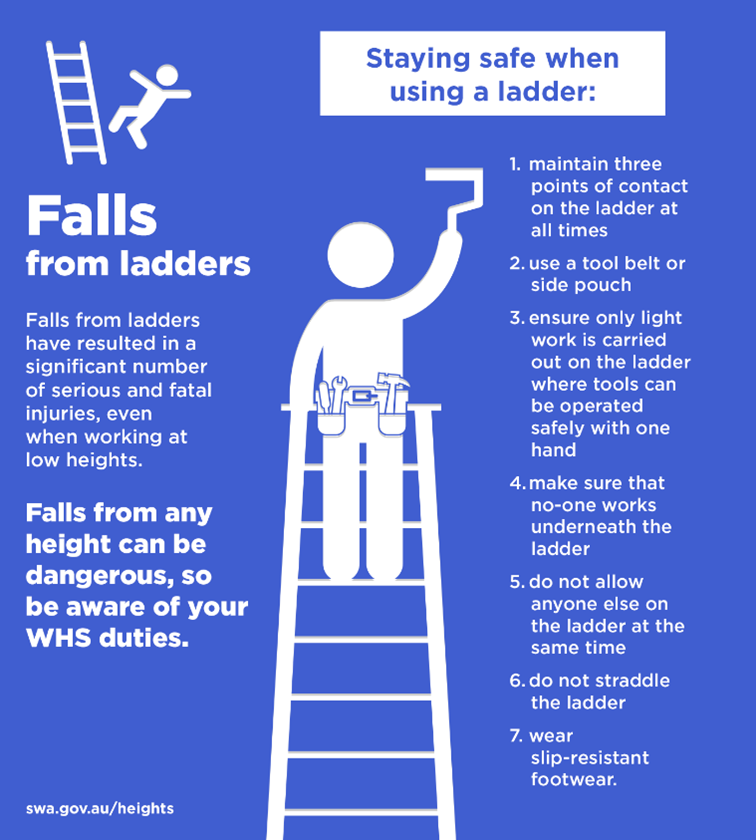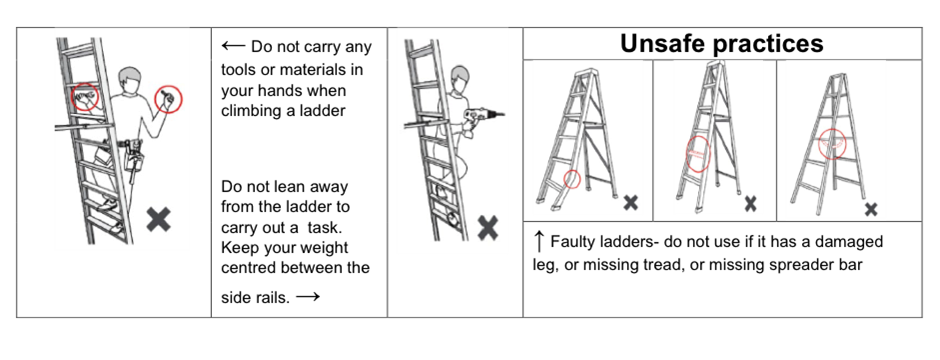Worker seriously injured after fall from a ladder
In May 2022, a worker sustained significant injuries after falling from a ladder. Early investigations indicate he was assisting with the installation of roofing sheets on a house renovation. For reasons yet to be established, the worker fell from the ladder suffering fractured ribs, a scratched diaphragm and other injuries.
Investigations are continuing.
These findings are not yet confirmed, and investigations are continuing into the exact cause.
Safety issues
There are fall hazards in many workplaces, especially where work is carried out at height. The risk of falling is common in construction but may also occur in other industries. Falls from ladders have resulted in many serious and fatal injuries, even when working at low heights. In managing the risk of falls, the Work Health and Safety Regulation 2011 requires specific control measures to be implemented, where it is reasonably practicable to do so.
Work involving ladders often leads to falls because of:
- ladder stability
- moving on or off the ladder
- the type of work
- the person leaning out to the side of the ladder.


Source: Safe Work Australia
Ways to manage health and safety
Taking steps to manage risks is a condition of doing business in Queensland. Effective risk management starts with a commitment to health and safety from those who manage the business. If an incident occurs, you'll need to show the regulator that you’ve used an effective risk management process. This responsibility is covered by your primary duty of care in the Work Health and Safety Act 2011.
Use the hierarchy of controls to help decide how to eliminate and reduce risks in your place of work. The hierarchy of controls ranks types of control methods from the highest level of protection and reliability to the lowest. It’s a step-by-step approach to eliminating or reducing risks. You must work through the hierarchy of controls when managing risks, with the aim of eliminating the hazard, which is the most effective control.
Possible control measures to prevent similar incidents
Although a risk management approach must be used to manage the risks of falls from heights, there are several regulatory provisions that business owners must comply with in different workplaces.
All workplaces
Part 4.4 of the Work Health and Safety Regulation 2011 - Falls and the Managing the risk of falls at workplaces Code of Practice 2021 (PDF, 3.9 MB).
Construction work
Section 291 of the Work Health and Safety Regulation 2011 identifies high risk construction work as work that - (a) involves a risk of a person falling more than 2m.
Section 299(1) of the Work Health and Safety Regulation 2011 requires that before high risk construction work commences a safe work method statement for the proposed work must be prepared.
Subdivisions 2 and 3 of Chapter 6 of the Work Health and Safety Regulation 2011 give specific requirements to control the risks of falls, the use of ladders and platforms supported by ladders used during construction work.
Hazards associated with working at height (where ladders may be used) that involve a risk of falling must be identified. The following control methods should be considered when working at height:
- substituting the hazard causing the risk with something of lesser risk
- for example - using an elevating work platform so workers can avoid standing on a ladder to perform the task
- where regular access is required, consider fixed access systems such as stairways and platforms
- implementing engineering controls
- for example - a travel restraint or fall-arrest system with adequate anchorage points.
Administrative controls are then used to minimise any residual risk. For example:
- implementing a safe system of work that considers:
- the design
- condition and layout of elevated work areas, including the distance of a potential fall and the load rating of the structure (ladders)
- correct setup, stability and security of ladders
- only light duty work is done using ladders, where three points of contact can by maintained and tools can be operated safely with one hand
- implementing safe systems for a travel restraint or fall-arrest system including the provision of adequate training, instruction and supervision in how to use them and in the emergency and rescue procedure should someone fall
- workers have been provided appropriate information and training to perform the task safely (young, new or inexperienced workers may be unfamiliar with a task).
If a risk remains, it must be minimised so far as reasonably practicable by using personal protective equipment (PPE). For example, wearing slip-resistant footwear and using a tool belt or side pouch.
Administrative control measures and PPE rely on human behaviour and supervision, and used on their own, tend to be least effective in minimising risks.
More information
- Managing the risk of falls at workplaces Code of Practice 2021 (PDF, 3.9 MB)
- How to manage work health and safety risks Code of Practice 2021 (PDF, 0.65 MB)
- Work at heights – construction
- Ladder safety – Infographic – Safe Work Australia
Support for people affected by a serious workplace incident
Have you been affected by a workplace fatality, illness or serious injury? For advice and support, visit our Facebook page or email ohs.coronialliaison@oir.qld.gov.au.